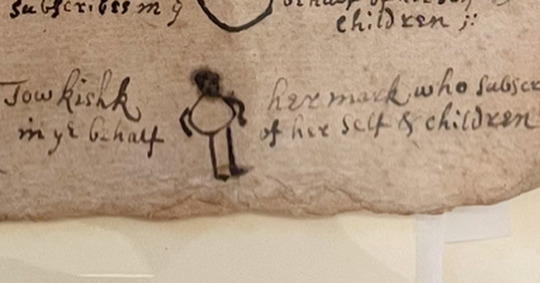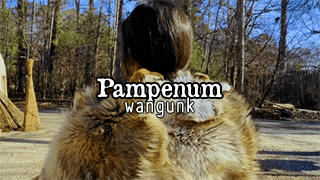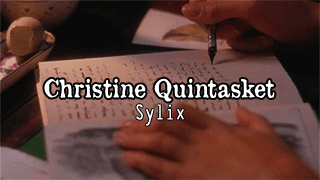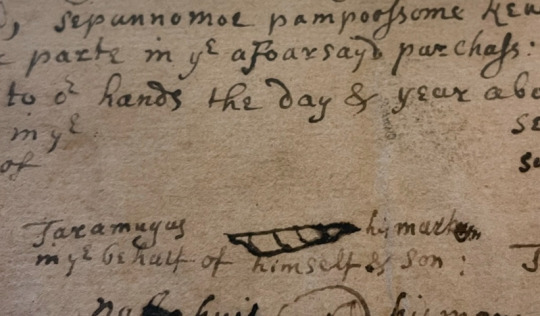#wangunk
Text

Towkishk. Her mark who subscribes in ye behalf of herself and children.
Wangunk. Their homelands across and around Pattaqounck or Pattaconk, in the southern part of present day central Connecticut. This document describes a part of land now called Haddam, Connecticut, “ …from mattabesett mill river to ye lower end of pattaquounck meadow on both sides of ye [Kwinitekw] river.”
In this deed, colonizers outline their desire for the land and “all ye trees stones mines minerals ponds brooks and rivers” in the area, in exchange for thirty coats.
Signed May 20, 1662. Seen at Mohegan Library and Archives.
#towkishk#wangunk#pattaconk#mattabesett#17thcentury#theirmarks#algonquian#easternwoodlands#nativehistory#17c#Connecticut#moheganlibraryandarchives
6 notes
·
View notes
Text








Historical Indigenous Women & Figures [6]:
Queen Nanny: the leader of the 18th century Maroon community in Jamaica, she led multiple battles in guerrilla war against the British, which included freeing slaves, and raiding plantations, and then later founding the community Nanny Town. There are multiple accounts of Queen Nanny's origins, one claiming that she was of the Akan people from Ghana and escaped slavery before starting rebellions, and others that she was a free person and moved to the Blue Mountains with a community of Taino. Regardless, Queen Nanny solidified her influence among the Indigenous People of Jamaica, and is featured on a Jamaican bank note.
Karimeh Abboud: Born in Bethlehem, Palestine, Karimeh Abboud became interested in photography in 1913 after recieving a camera for her 17th birthday from her Father. Her prestige in professional photography rapidly grew and became high demand, being described as one of the "first female photographers of the Arab World", and in 1924 she described herself as "the only National Photographer".
Georgia Harris: Born to a family of traditional Catawba potters, Harris took up pottery herself, and is credited with preserving traditional Catawba pottery methods due to refusing to use more tourist friendly forms in her work, despite the traditional method being much more labour intensive. Harris spent the rest of her life preserving and passing on the traditional ways of pottery, and was a recipient of a 1997 National Heritage Fellowship awarded by the National Endowment for the Arts, which is the highest honor in the folk and traditional arts in the United States.
Nozugum: known as a folk hero of the Uyghur people, Nozugum was a historical figure in 19th century Kashgar, who joined an uprising and killed her captor before running away. While she was eventually killed after escaping, her story remains a treasured one amongst the Uyghur.
Pampenum: a Sachem of the Wangunk people in what is now called Pennsylvania, Pampenum gained ownership of her mother's land, who had previously intended to sell it to settlers. Not sharing the same plans as her mother, Pampenum attempted to keep these lands in Native control by using the colonial court system to her advantage, including forbidding her descendants from selling the land, and naming the wife of the Mohegan sachem Mahomet I as her heir. Despite that these lands were later sold, Pampenum's efforts did not go unnoticed.
Christine Quintasket: also known as "Humishima", "Mourning Dove", Quintasket was a Sylix author who is credited as being one of the first female Native American authors to write a novel featuring a female protagonist. She used her Sylix name, Humishima, as a pen name, and was inspired to become an author after reading a racist portrayal of Native Americans, & wished to refute this derogatory portrayal. Later in life, she also became active in politics, and helped her tribe to gain money that was owed them.
Rita Pitka Blumenstein: an Alaskan Yup'ik woman who's healing career started at four years old, as she was trained in traditional healing by her grandmother, and then later she became the first certified traditional doctor in Alaska and worked for the Alaska Native Tribal Health Consortium. She later passed on her knowledge to her own daughters. February 17th is known as Rita Pitka Blumenstein day in Alaska, and in 2009 she was one of 50 women inducted into the inaugural class of the Alaska Women's Hall of Fame
Olivia Ward Bush-Banks: a mixed race woman of African American and Montaukett heritage, Banks was a well known author who was a regular contributor to the the first magazine that covered Black American culture, and wrote a column for a New York publication. She wrote of both Native American, and Black American topics and issues, and helped sculptor Richmond Barthé and writer Langston Hughes get their starts during the Harlem Renaissance. She is also credited with preserving Montaukett language and folklore due to her writing in her early career.
part [1], [2], [3], [4], [5] Transphobes & any other bigots need not reblog and are not welcome on my posts.
529 notes
·
View notes
Text
Community Historians and Academics Establish Wangunk Studies Working Group
Gary O’Neil, Red Oak
Middletown CT, 24 July 2024 – a group of independent community historians and academic scholars met at Russell Library to form a Wangunk Studies Working Group, a body of individuals working together to focus on research and scholarship about the Wangunk, the Native people indigenous to a large portion of central Connecticut. Founding convenor J. Kēhaulani Kauanui approached…

View On WordPress
0 notes
Text
1 note
·
View note
Photo

Wangunk Statue in Middletown, Connecticut
The Wangunk were a group of Native peoples who lived along the Connecticut River in a region they called Mattabesett located where the modern towns of Portland, Haddam, East Hampton, and Middletown now lie. They were part of the larger Algonquian language and culture family. When Europeans entered the area, the Wangunk sachem Sowheag sold them some of his people’s land but kept two large patches on both sides of the river, including a large hill on the Western side. Sowheag had a walled fortification built here to protect his people from further European incursions and from conflict with other Native peoples. The Wangunk engaged in some fur trading with the Europeans, though they quickly ran into conflict with the Pequot, who were trying to exert more control over trading in the region that would eventually become Connecticut. Today the Wangunk are no longer a cohesive tribe, nor are they recognized by the federal or state government. However, several people still identify as Wangunk and are attempting to reclaim some of their history and culture. At Harbor Park in Middletown, Connecticut, a large stone sculpture of a stylized man’s head serves as a tribute and remembrance of the Wangunk’s history in the region.
https://www.atlasobscura.com/places/wangunk-statue
0 notes
Link
Subscribe for Daily Updates: TODAYINCTHISTORY.com
0 notes
Text
Top Three Museums in Hartford CT 06103
Hartford is a beautiful city in the state of Connecticut, USA. It was settled in the early 17th century by Dutch fur traders, therefore making them the first Non-indigenous settlers in the area. Prior to this event, the Hartford area and its surroundings were occupied by Algonquin Native American tribes like the Podunks, Poquonocks, Tunxis, Massacoes, Wangunks and the Saukiogs. These tribes and the European settlers played an important role in shaping the culture of the area. Today, the beautiful histories of Hartford and Connecticut as whole are well preserved in the numerous museums in the area and top three of them are.

Hartford Science Center: this is a haven for science and history lover. It is a nine-story building located at 250 Columbus Blvd, Hartford, CT 06103, United States. It was established with aim of showcasing tremendous growth of science the area has experienced over the years.
Wadsworth Atheneum Museum of Art: this is an art museum located at 600 Main St, Hartford, CT 06103, United States. It is a large historic building that houses all manners of artworks spanning different centuries. Its exhibitions concentrate on European Baroque arts, ancient Egyptian and Classical bronzes as well as American and French artworks.
Mark Twain House and Museum: this is a history museum located at 351 Farmington Ave, Hartford, CT 06105, United States. It was the home of Samuel Langhorne Clemens between the mid to late 19th century and it was built in a beautiful American High Gothic Style.
Members Spotlight
Connecticut Bail Bonds Group
11 Asylum St, Suite 512
Hartford CT 06103
860 420-2245
https://www.connecticut-bailbonds.com
Connecticut Bail Bonds Group is one of the best bail bond Hartford has and they are known for the long and efficient services they have been providing the people of the city. Their aim is to help people with their bail requirement as fast and convenient as possible.
Get Map Directions:-
1 note
·
View note
Text
<p>Just saw the Lenape Land Acknowledgement. Moving.</p> <p>I would like to acknowledge the land where we will gather in this time of thanks was once, and still is, inhabited by the Wangunks, the Mohegans and the Nehantics who called the land “Machimoodus,” the place of noises.</p>
0 notes
Text
Newington Public Schools to Change Mascot From Indians
Newington Public Schools officials are looking to change the mascot from the Indians. Superintendent Dr. Maureen Brummett confirmed that a committee will convene this fall and work toward picking a new mascot. According to the Newington Public Schools website, “the Sachem of the Wangunks represents the school mascot. He originally sold the land on which Newington stands to the settlers.”...
from Local – NBC Connecticut https://www.nbcconnecticut.com/news/local/newington-public-schools-to-change-mascot-from-indians/2292499/
0 notes
Text

Tarramuggus. Turramuggas. Terramuggas. Taramugus his marke in ye behalf of himself & son.
Wangunk. Their homelands across and around Pattaqounck or Pattaconk, in the southern part of present day central Connecticut. This document describes a part of land now called Haddam, Connecticut, “ …from mattabesett mill river to ye lower end of pattaquounck meadow on both sides of ye [Kwinitekw] river.” The deed sets aside “Thirty mile Island & forty acres of land at pattaquounck which they [Wangunk] doe reserve…for them and their assignsf from ye day of ye date hereof forever without any interruption or molestation…”
Their kin: a father, Sowheage. A sister, Sepunnamo or Sepunnemoe. A partner, Keseso. A son, Peetoosoh.
Signed May 20, 1662. Seen at Mohegan Library and Archives.
#turramuggas#wangunk#pattaconk#connecticut#haddamconnecticut#mattabesett#theirmarks#17thcentury#17c#moheganlibraryandarchives#algonquian#easternwoodlands#nativehistory
2 notes
·
View notes
Note
Hi, your "Historical Indigenous Women and Figures [6]" post came across my dash, and I have a correction for you in under the Pampenum section. The Wangunk (and thus Pampenum) are from Quinnetukut, what is now called Connecticut. The name "Wangunk" literally means "where the river bends", because their traditional territory is along a bend in the Connecticut River.
Ohh thank you!! I'll fix it soon :)
12 notes
·
View notes
Text
The Will of Timothy Indian, A Christian Man of Farmington
The Will of Timothy Indian, A Christian Man of Farmington
By Katherine A. Hermes, with Sarajane Cedrone, who transcribed the will and inventory.
In the mid-to-late eighteenth century, Farmington was home to a group of Christian Native people who lived in an indigenous community, but who often emulated the colonists both in religion and law. This new Christian community drew Native people from the Mohegan (New London County), Wangunk (Middlesex County),…
View On WordPress
0 notes
Text
Pequot History
Pequot History begins about 11,000 years ago, in Mashantucket, but it was not the same as it is today. Back then it was much warmer, but the winters were still very harsh. There was much open woodland in this region and it was much more hospitable than the rocky landscape that was left a few thousand years earlier. Their key to survival at this time was knowing when and where to find special kinds of food, such as caribou, edible species of plant, and when certain kinds of fish.
The Pequot were a nomadic people, following the food where it goes taking what few possessions that they had with them. They didn't maintain a permanent site as "home" either. The most practical group size that they had was large enough to hunt but small enough to be self sufficient and mobile, with these groups consisting of 10 to 25 people.
The Pequot war was one of the most bloody wars and one of the most controversial wars in colonial and Native American History. It wasn't just a single attack on the Pequot, it had numerous battles in Rhode Island and Connecticut. A lot of Native American tribes fought for and against the Pequot, some of these groups were the Sasqua of Fairfield, the Quinnipiac of New Haven, the Western Niantic, the Mohegan, the Narragansett, the Nipmuck, the Wangunk, and the Podunk. The most heartbreaking event during this war is the Mystic Massacre, where the English led by John Mason and John Underhill, along with their allies from the Mohegan and Narragansett tribes, surrounded one of the two main fortified settlements at Mistick. 20 soldiers breached the gates and they had to use fire to escape after being overwhelmed, which caused chaos in the town. Most of the villagers died in the flames, and those who escaped were slain at the exit of their home.
Today, after fighting long and hard for their right to have their land, they have a Garden and Greenhouse to grow crops, they are run by a seven-member Tribal Council, which is led by a council chairman, and an Elders Council, which consists of all tribal members that are 55 years or older. They also have their own casino as well, which got put into play by the Indian Gaming Rights Act. With this casino, they were able to help boost their economy as well.
Jordon Alagna
0 notes
Text

Sepinnamo His Marke & Seal
Wangunk. Their homelands in and around so-called “Wethersfield, Connecticut,” and south along the Kwinitekw or Connecticut River. Sepinnamo’s name has also been spelled as Sepunnamo and Spunnoe.
This document addresses land at present-day Weathersfield, Connecticut, formerly, and perhaps still known by Algonquian-speaking people as Poquioag. The document suggests that it is to serve as an official and legal agreement between settlers and the Wangunk and others, to “prevent future troubles'' because the “Lands as aforesaid hath Been quietly Possessed by the English Now for Severall years passt, but in as much as there is no written deed to be found under the Hand of the Said Sowheag”. Sowheag, the document says, previously granted settlers access to Poquioag, now Weathersfield, for “12 yards of trading cloath.”
Sepinamo’s kin: Their father, Sowheag, sachem of the Wangunk; siblings and other relations as listed in the document: “Turramuggus Sepuynamaw Squaw daughter to Souheag,: Spunno: Nabowhee Weseunshiee Waphancke True Heires of and Rightfull Successessors To the aforsaid Souheag[.]”
We have previously posted another Wangunk leader with a similar name: Supunnemoe or Sepimamaus, who was Sepinamo’s sister. However, the documentation of each person in across various records brings more confusion than clarity, so more work needs to be done here!
Deed signed December 25, 1671. [What seems to be] A copy of the original seen at Newberry Library.
#sepinnamo#wangunk#sowheag#connecticut#wethersfield#newberrylibrary#theirmarks#17thcentury#17c#algonquian#easternwoodlands#nativehistory
0 notes
Text

Sepunnemoe. Her mark whoe subscribes in ye behalf of herself and children.
Wangunk. Their homelands across and around Pattaqounck or Pattaconk, in the southern part of present day central Connecticut. This document describes a part of land now called Haddam, Connecticut, “ …from mattabesett mill river to ye lower end of pattaquounck meadow on both sides of ye [Kwinitekw] river.”
Sepunnemoe's name has also been seen spelled as Sepimamaus.
Signed May 20, 1662. Seen at Mohegan Library and Archives.
#sepunnemoe#wangunk#pattaconk#connecticut#haddamconnecticut#mattabesett#theirmarks#17thcentury#17c#moheganlibraryandarchives#algonquian#easternwoodlands#nativehistory
0 notes